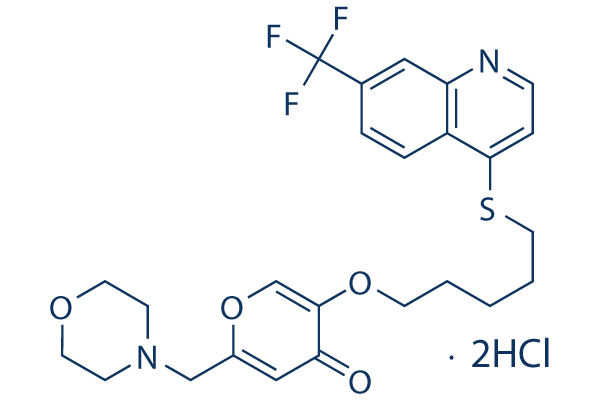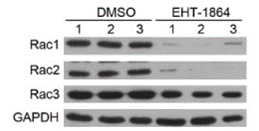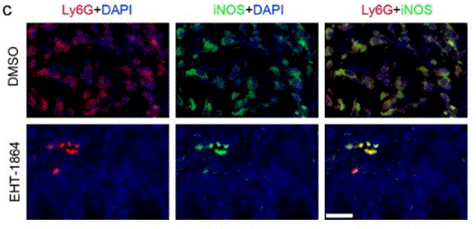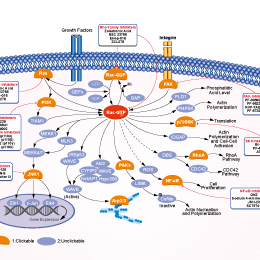
- Bioactive Compounds
- By Signaling Pathways
- PI3K/Akt/mTOR
- Epigenetics
- Methylation
- Immunology & Inflammation
- Protein Tyrosine Kinase
- Angiogenesis
- Apoptosis
- Autophagy
- ER stress & UPR
- JAK/STAT
- MAPK
- Cytoskeletal Signaling
- Cell Cycle
- TGF-beta/Smad
- DNA Damage/DNA Repair
- Compound Libraries
- Popular Compound Libraries
- Customize Library
- Clinical and FDA-approved Related
- Bioactive Compound Libraries
- Inhibitor Related
- Natural Product Related
- Metabolism Related
- Cell Death Related
- By Signaling Pathway
- By Disease
- Anti-infection and Antiviral Related
- Neuronal and Immunology Related
- Fragment and Covalent Related
- FDA-approved Drug Library
- FDA-approved & Passed Phase I Drug Library
- Preclinical/Clinical Compound Library
- Bioactive Compound Library-I
- Bioactive Compound Library-Ⅱ
- Kinase Inhibitor Library
- Express-Pick Library
- Natural Product Library
- Human Endogenous Metabolite Compound Library
- Alkaloid Compound LibraryNew
- Angiogenesis Related compound Library
- Anti-Aging Compound Library
- Anti-alzheimer Disease Compound Library
- Antibiotics compound Library
- Anti-cancer Compound Library
- Anti-cancer Compound Library-Ⅱ
- Anti-cancer Metabolism Compound Library
- Anti-Cardiovascular Disease Compound Library
- Anti-diabetic Compound Library
- Anti-infection Compound Library
- Antioxidant Compound Library
- Anti-parasitic Compound Library
- Antiviral Compound Library
- Apoptosis Compound Library
- Autophagy Compound Library
- Calcium Channel Blocker LibraryNew
- Cambridge Cancer Compound Library
- Carbohydrate Metabolism Compound LibraryNew
- Cell Cycle compound library
- CNS-Penetrant Compound Library
- Covalent Inhibitor Library
- Cytokine Inhibitor LibraryNew
- Cytoskeletal Signaling Pathway Compound Library
- DNA Damage/DNA Repair compound Library
- Drug-like Compound Library
- Endoplasmic Reticulum Stress Compound Library
- Epigenetics Compound Library
- Exosome Secretion Related Compound LibraryNew
- FDA-approved Anticancer Drug LibraryNew
- Ferroptosis Compound Library
- Flavonoid Compound Library
- Fragment Library
- Glutamine Metabolism Compound Library
- Glycolysis Compound Library
- GPCR Compound Library
- Gut Microbial Metabolite Library
- HIF-1 Signaling Pathway Compound Library
- Highly Selective Inhibitor Library
- Histone modification compound library
- HTS Library for Drug Discovery
- Human Hormone Related Compound LibraryNew
- Human Transcription Factor Compound LibraryNew
- Immunology/Inflammation Compound Library
- Inhibitor Library
- Ion Channel Ligand Library
- JAK/STAT compound library
- Lipid Metabolism Compound LibraryNew
- Macrocyclic Compound Library
- MAPK Inhibitor Library
- Medicine Food Homology Compound Library
- Metabolism Compound Library
- Methylation Compound Library
- Mouse Metabolite Compound LibraryNew
- Natural Organic Compound Library
- Neuronal Signaling Compound Library
- NF-κB Signaling Compound Library
- Nucleoside Analogue Library
- Obesity Compound Library
- Oxidative Stress Compound LibraryNew
- Plant Extract Library
- Phenotypic Screening Library
- PI3K/Akt Inhibitor Library
- Protease Inhibitor Library
- Protein-protein Interaction Inhibitor Library
- Pyroptosis Compound Library
- Small Molecule Immuno-Oncology Compound Library
- Mitochondria-Targeted Compound LibraryNew
- Stem Cell Differentiation Compound LibraryNew
- Stem Cell Signaling Compound Library
- Natural Phenol Compound LibraryNew
- Natural Terpenoid Compound LibraryNew
- TGF-beta/Smad compound library
- Traditional Chinese Medicine Library
- Tyrosine Kinase Inhibitor Library
- Ubiquitination Compound Library
-
Cherry Picking
You can personalize your library with chemicals from within Selleck's inventory. Build the right library for your research endeavors by choosing from compounds in all of our available libraries.
Please contact us at info@selleckchem.com to customize your library.
You could select:
- Antibodies
- Bioreagents
- qPCR
- 2x SYBR Green qPCR Master Mix
- 2x SYBR Green qPCR Master Mix(Low ROX)
- 2x SYBR Green qPCR Master Mix(High ROX)
- Protein Assay
- Protein A/G Magnetic Beads for IP
- Anti-Flag magnetic beads
- Anti-Flag Affinity Gel
- Anti-Myc magnetic beads
- Anti-HA magnetic beads
- Poly DYKDDDDK Tag Peptide lyophilized powder
- Protease Inhibitor Cocktail
- Protease Inhibitor Cocktail (EDTA-Free, 100X in DMSO)
- Phosphatase Inhibitor Cocktail (2 Tubes, 100X)
- Cell Biology
- Cell Counting Kit-8 (CCK-8)
- Animal Experiment
- Mouse Direct PCR Kit (For Genotyping)
- New Products
- Contact Us
research use only
EHT 1864 2HCl Rho inhibitor
EHT 1864 2HCl is a potent Rac family GTPase inhibitor with Kd of 40 nM, 50 nM, 60 nM and 250 nM for Rac1, Rac1b, Rac2 and Rac3, respectively.

Chemical Structure
Molecular Weight: 581.47
Purity & Quality Control
Batch:
Purity:
99.97%
99.97
Related Products
| Related Targets | Cdc42-subclass Rac Rho-subclass | Click to Expand |
|---|---|---|
| Related Products | NSC 23766 trihydrochloride CCG-1423 EHop-016 ML141 ZCL278 MBQ-167 CCG-203971 Rhosin hydrochloride CID44216842 | Click to Expand |
| Related Compound Libraries | Kinase Inhibitor Library PI3K/Akt Inhibitor Library MAPK Inhibitor Library DNA Damage/DNA Repair compound Library Cell Cycle compound library | Click to Expand |
Signaling Pathway
Cell Culture and Working Concentration
| Cell Lines | Assay Type | Concentration | Incubation Time | Formulation | Activity Description | PMID |
|---|---|---|---|---|---|---|
| NIH3T3 | Function assay | 5 uM | Inhibition of lysophosphatidic acid-induced actin stress fibers formation in mouse NIH3T3 cells at 5 uM | 17932039 | ||
| NIH3T3 | Function assay | 5 uM | Inhibition of bradykinin-induced filopodia formation in mouse NIH3T3 cells at 5 uM | 17932039 | ||
| 293T | Function assay | Effect on Rac1 binding to RhoGDI1 expressed in 293T cells by Western blot analysis | 17932039 | |||
| 293T | Function assay | Effect on Rac1 binding to RhoGDI2 expressed in 293T cells by Western blot analysis | 17932039 | |||
| NIH3T3 | Function assay | Effect on Rac1 binding to RhoGDI1 in mouse NIH3T3 cells by Western blot analysis | 17932039 | |||
| NIH3T3 | Function assay | Effect on Rac1 binding to RhoGDI2 in mouse NIH3T3 cells by Western blot analysis | 17932039 | |||
| NIH3T3 | Function assay | 5 uM | 3 to 5 weeks | Inhibition of Rac1 61L mutant-induced cellular transformation in mouse NIH3T3 cells at 5 uM after 3 to 5 weeks | 17932039 | |
| NIH3T3 | Function assay | 5 uM | Inhibition on Tiam1 C1199 mutant-induced focus forming activity in mouse NIH3T3 cells at 5 uM | 17932039 | ||
| NIH3T3 | Function assay | 5 uM | Inhibition of Ras-induced cell growth in H-Ras 61L expressing mouse NIH3T3 cells at 5 uM by MTT assay | 17932039 | ||
| U87MG | Function assay | Reduction of RhoA-GTPase level in platelet derived growth factor-induced human U87MG cells measured with GST-rhotekin-RBD by pulldown assay | 17932039 | |||
| Click to View More Cell Line Experimental Data | ||||||
Mechanism of Action
| Targets |
|
|---|
In vitro |
||||
| In vitro | EHT 1864 selectively inhibits Rac-induced lamellipodia formation, and specifically reverses cell transformation induced by constitutively activated mutants of Rac1 and Tiam1. EHT 1864 strongly impaires oncogenic Ras-induced cell proliferation in NIH 3T3 cells stably expressing H-Ras(61L) protein. [1] EHT 1864 also reduces both extracellular and intracellular levels of Aβ peptides by inhibiting the γ-secretase-dependent cleavage of APP. [2] In cultured hippocampal pyramidal neurons, EHT 1864, via inhibition of Rac1, rescues the phenotype induced by Rich2 knock-down. [3] | |||
|---|---|---|---|---|
| Kinase Assay | Inhibitor:GTPase binding analyses | |||
| For inhibitor:GTPase binding analyses, aliquots of small GTPase solution (containing 1 μM inhibitor) are titrated into a solution of 1 μM inhibitor in the cuvette. Changes in fluorescence anisotropy are monitored at λex = 360 nm, λem = 440 nm, 30 s after each addition. All data analysis and curve fitting were performed using Microsoft Excel and QuantumSoft's ProFit for Mac OS X. | ||||
| Cell Research | Cell lines | NIH 3T3 cells | ||
| Concentrations | ~5 μM | |||
| Incubation Time | 4 days | |||
| Method | NIH 3T3 cells stably expressing oncogenic Ras are plated in 96-well plates. The cells are cultured for up to 4 days in complete growth medium, either alone, or supplemented with 5 μM EHT 1864. Cell growth is then assessed using the conversion of MTT to a formazan product. Briefly, the MTT reagent (from a 5 mg/ml solution diluted in PBS) is added to the wells at a final concentration of 0.5 mg/ml, and the cells are further incubated for 4 h at 37°C. The medium is then removed, and the reaction is terminated by adding 100 μl/well Me2SO. The absorbance is read at 570 nm using a microplate reader. | |||
| Experimental Result Images | Methods | Biomarkers | Images | PMID |
| Western blot | Rac1 / Rac2 / Rac3 p-STAT3 / STAT3 / p-Bcl-2 / Bcl-2 / Rac1 |

|
29416921 | |
| Immunofluorescence | iNOS |

|
29416921 | |
In Vivo |
||
| In vivo | EHT 1864 (40 mg/kg i.p.) significantly reduces Abeta 40 and Abeta 42 levels in guinea pig brains. [2] | |
|---|---|---|
| Animal Research | Animal Models | Male Hartley albino guinea pigs |
| Dosages | 40 mg/kg daily | |
| Administration | i.p. | |
References |
|
Chemical Information
| Molecular Weight | 581.47 | Formula | C25H29Cl2F3N2O4S |
| CAS No. | 754240-09-0 | SDF | Download SDF |
| Synonyms | N/A | ||
| Smiles | C1COCCN1CC2=CC(=O)C(=CO2)OCCCCCSC3=C4C=CC(=CC4=NC=C3)C(F)(F)F.Cl.Cl | ||
Storage and Stability
| Storage (From the date of receipt) | |||
|
In vitro |
DMSO : 100 mg/mL ( (171.97 mM) Moisture-absorbing DMSO reduces solubility. Please use fresh DMSO.) Water : 100 mg/mL Ethanol : Insoluble |
Molecular Weight Calculator |
|
In vivo Add solvents to the product individually and in order. |
In vivo Formulation Calculator |
|||||
Preparing Stock Solutions
Molarity Calculator
In vivo Formulation Calculator (Clear solution)
Step 1: Enter information below (Recommended: An additional animal making an allowance for loss during the experiment)
mg/kg
g
μL
Step 2: Enter the in vivo formulation (This is only the calculator, not formulation. Please contact us first if there is no in vivo formulation at the solubility Section.)
% DMSO
%
% Tween 80
% ddH2O
%DMSO
%
Calculation results:
Working concentration: mg/ml;
Method for preparing DMSO master liquid: mg drug pre-dissolved in μL DMSO ( Master liquid concentration mg/mL, Please contact us first if the concentration exceeds the DMSO solubility of the batch of drug. )
Method for preparing in vivo formulation: Take μL DMSO master liquid, next addμL PEG300, mix and clarify, next addμL Tween 80, mix and clarify, next add μL ddH2O, mix and clarify.
Method for preparing in vivo formulation: Take μL DMSO master liquid, next add μL Corn oil, mix and clarify.
Note: 1. Please make sure the liquid is clear before adding the next solvent.
2. Be sure to add the solvent(s) in order. You must ensure that the solution obtained, in the previous addition, is a clear solution before proceeding to add the next solvent. Physical methods such
as vortex, ultrasound or hot water bath can be used to aid dissolving.
Tech Support
Answers to questions you may have can be found in the inhibitor handling instructions. Topics include how to prepare stock solutions, how to store inhibitors, and issues that need special attention for cell-based assays and animal experiments.
Tel: +1-832-582-8158 Ext:3
If you have any other enquiries, please leave a message.
* Indicates a Required Field






































